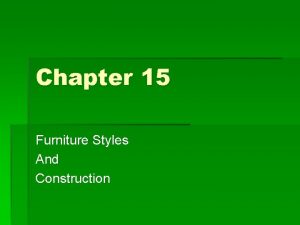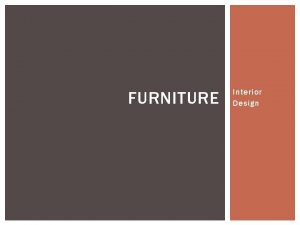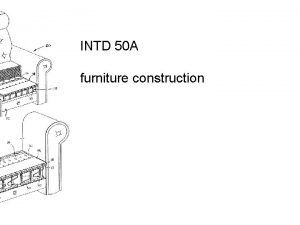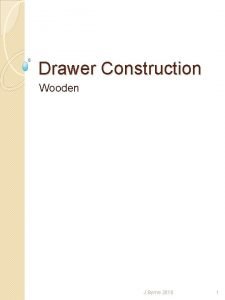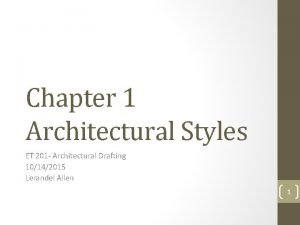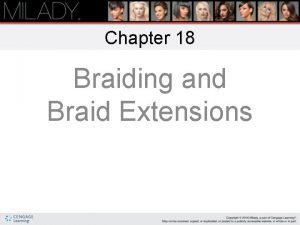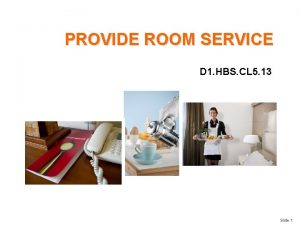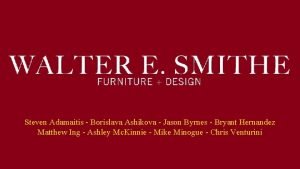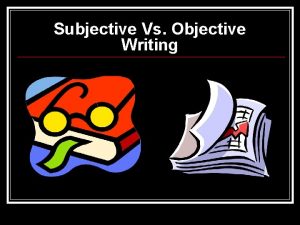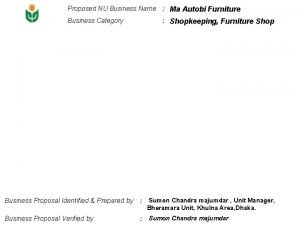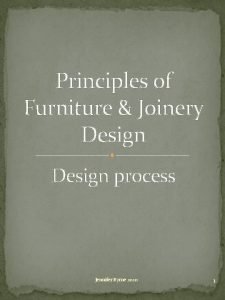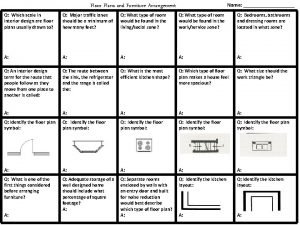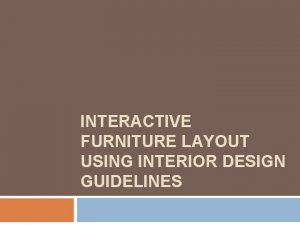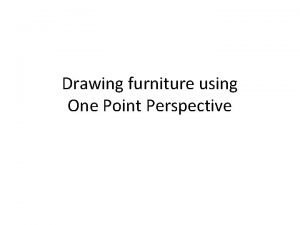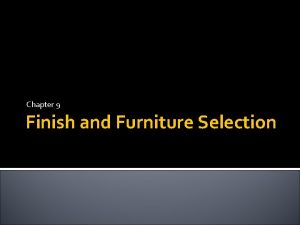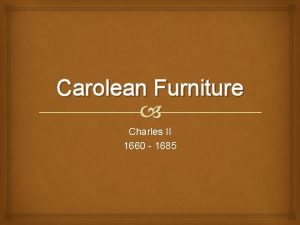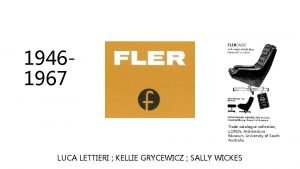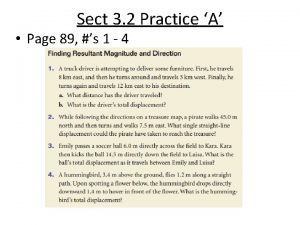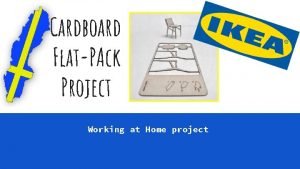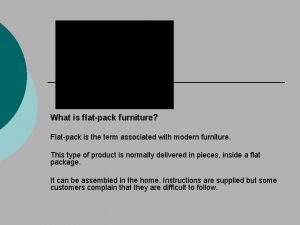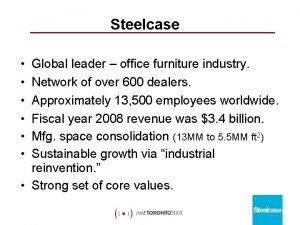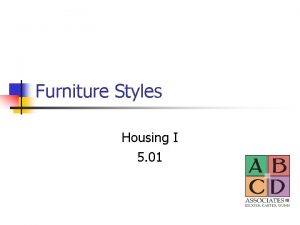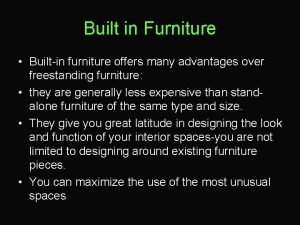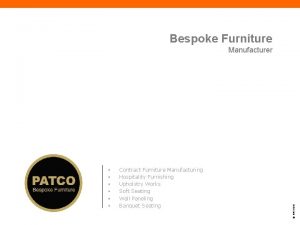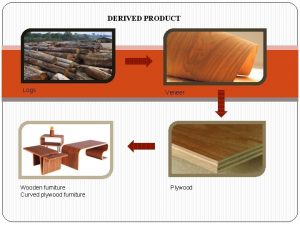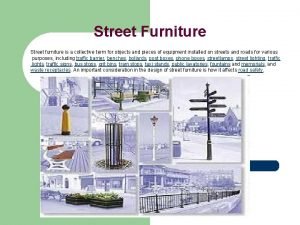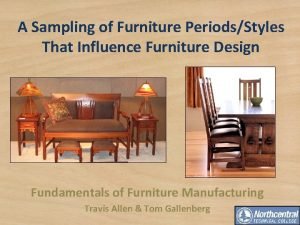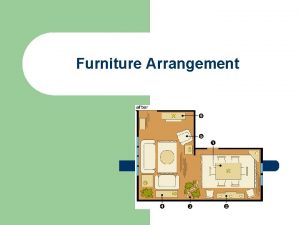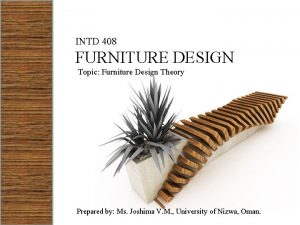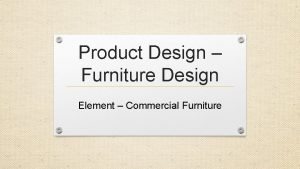Chapter 15 Furniture Styles And Construction Traditional or






















































- Slides: 54

Chapter 15 Furniture Styles And Construction

Traditional or Period § French, English and American § These traditions or periods have survived the test of time. § Still used today § Most styles are named after rulers of the era or of the craftsmen who created them.

France § King Louis XIII of France 1610 -1643 § Age 8 ½ § Grand formal § Rich inlays, carvings and classical motifs

Twist arms/legs – lions head arm ends King Louis XIII

Louis XIV ruled 1643 -1715 He was 5 years old § Built the Palace of Versailles He filled it with extravagant furnishings.

The Palace is ¼ mile long

Hall of Mirrors & Kings Bedroom windows mirrors Bed

Louis XIV Furniture had heavy ornamentation and Commode gold overlays. Bed Queen’s chambers

Louis XV – 1715 -1774 Great-grandfather was Louis XIV, also 5 yr. old King § Small proportions and more delicate § Curved lines, soft colors

Louis XVI – 1774 – 1792 He was 20 when King and both executed 1793 for treason He was 14 when he married and it took 3 years for them to consummate their marriage § He and Marie Antoinette ruled France § Simple, straight lines. Can also see fluted columns

Empire – dignified style 1804 -1815 § Napoleon dominated everything § Large and heavy § Greek, Egyptian, Roman § motifs

French Provincial 17 th and 18 century § Practical, functional, comfortable

Can you identify these French Styles? 3. 1. 2. 4.

Can you identify these French Styles? French Provincial Empire Louis XV Louis XIII

England § Royalty were still greatly responsible for influencing furniture styles § Designers also influenced styles Queen Anne Chippendale Hepplewhite

Jacobean – 1603 -1649 § Turning and fluting of wood § Very sturdy, massive, made to last and Extremely uncomfortable Turning Lathe

Queen Anne 1702 - 1714 § Oriental influence § Cabriole leg -gentle S-shaped curve that ends in a decorative foot § Also carved fans and shells can be seen

Chippendale 1714 - 1820 furniture designer § Gothic and Chinese influence § Curved top edges on backs of chairs. § BALL and CLAW feet Camelback sofa

Hepplewhite – furniture designer 1714 - 1820 § Graceful designs § Backs of chairs had shield, oval or heart shapes.

Thomas Sheraton 1714 - 1820 § Motifs of urns, swags and leaves § Inventor Washstand Chamber pot

Regency named after Prince of Wales 1810 - 1837 § Reflects cultures in Greece, Rome and Egypt § Bold curved lines

Victorian Queen Victoria 1837 - 1901 § Excessive use of ornamentation § Massive proportions and dark colors Marble top

Can you identify the English designers and/or styles? 1. 3. 2. 4.

Can you identify these English styles? 1. Victorian 3. Hepplewhite 2. Jacobean 4. Chippendale

American – Early American § Furniture was practical and less massive Windsor Ladder-back Canopy bed

Colonial § Fully upholstered WINGBACK § S-shaped legs and graceful lines § Provided protection from drafts

Federal - after American Revolution § Classic influences – patriotic symbols § Eagles, stars and stripes

Duncan Phyfe – furniture designer § Lyre motif on backs of chairs § Brass-tipped dog feet, curved legs Lyre back

Shaker § Very plain in design, but sometimes painted in dull colors

Can you identify the names of these American styled furnishings? 3. 2. 1. 4.

Can you identify these American styles? 3. candlestick 2. Windsor 1. Wingback 4. ladderback

th 20 Century Furniture Styles § Modern Period § Simpler lines and forms § Abstract form § Designers rejected the traditional styles Marshmallow sofa

Art Nouveau – French for “New Art” § § § Began in the 1800’s – early 1900’s Style influenced by Japanese motifs Flowing lines of nature, vines, blossoms

De Stijl – means “The Style” § Abstract art § Geometric forms, like rectangles ZIGZAG chair

Bauhaus – early 1900’s § Form Follows Function § Very simple design § Chrome-plated steel tubing for support § Seats & backs of canvas, wood, cane or leather Barcelona chair

Organic Design or Style § Name given to Frank Lloyd Wright 1869 -1959 § Designed to complement their natural surrounding, usually geometric shapes, flat surfaces and slats § Furniture created specifically for each designed house.

Frank Lloyd Wright § Prairie style architecture Robie House, Chicago, Illinois Barrel chair

Fallingwater – Pittsburgh, Pennsylvania

Art Deco most popular 1920’ & ’ 30’s § Images suggest speed, fast trains, ocean liners and cars. Tulip chair

Modern Scandinavian § Denmark, Norway and Sweden late 1920’s § Molded wood seat or arms for chairs § Natural wood with simple lines and simple upholstery fabrics

Late 20 th Century Styles § § § Retro Radical Modern Postmodern

Retro - Popular 1950’s and ’ 60’s Clean, flowing, usually no ornamentation Butterfly chair – Hugs the body Single most important design By Eames Polyfoam modular units

Radical Modern – late 1960’s § Inexpensive, useable, but longevity Cloth, leather or vinyl The bean bag chair

Postmodern Design – late 1900’s Modular top table “Queen Anne” molded plywood And laminated finish

Can you identify the designer or the style period? 1. 3. 2. 4.

Can you identify the designer or the style period? 1. Bauhaus 3. Art Deco 2. Frank L. Wright 4. Modern

Can you identify these furnishings from the 20 th Century? 2. 1. 4. 3. 5.

Can you identify these furnishings from the 20 th Century? 1. Bean bag 2. Tulip 4. Barcelona 3. Zigzag 5. Butterfly

Use of modular/modern

Other fun shapes for chairs Egg Chair Pod chair Ball chair Bubble chair Jane lounge

Notable furniture § § § Gate-leg table Trestle table Trundle bed Chair table Drop-leaf Trestle table

Antique vs. Collectible § Antique - furniture that is at least 100 years old Lunch pail 1902 § Collectible – highly valued, if kept long enough will become antique.

§ § § Cards 1 -3 TABLE 1 Cards 4 -6 TABLE 2 Cards 7 -9 TABLE 3 Cards 10 -12 TABLE 4 Cards 13 -15 TABLE 5 Cards 16 -18 LIGHT TABLE

Activity § Summarize your card into a paragraph (6 -8 sentences) § Find (4) facts from books about your furniture style § Find (4) examples of your furniture style within the books – put a post-it to mark the page § SKETCH CARDS AND EXAMPLES
 Chapter 15 furniture styles and construction answer key
Chapter 15 furniture styles and construction answer key Furniture styles
Furniture styles Upholstered furniture construction
Upholstered furniture construction Traditional drawer construction
Traditional drawer construction Chapter 1 architectural styles
Chapter 1 architectural styles The country which is known for its unique vocals
The country which is known for its unique vocals Preparing textured hair for braiding
Preparing textured hair for braiding Room service account
Room service account Walter e smithe brothers
Walter e smithe brothers Where does the word drama come from
Where does the word drama come from The scenery backdrops and furniture that create the setting
The scenery backdrops and furniture that create the setting Management theories in nursing
Management theories in nursing Lemasters and defrain
Lemasters and defrain Push pull influencing
Push pull influencing Impersonal words examples
Impersonal words examples Architectural styles and patterns
Architectural styles and patterns Examples of informal communication
Examples of informal communication Orality vs literacy
Orality vs literacy What is modified block style
What is modified block style Formal and informal writing styles
Formal and informal writing styles Black and white styles in conflict
Black and white styles in conflict Ping pong conversation style
Ping pong conversation style Conventional lines
Conventional lines 7 learning styles and vark similarities
7 learning styles and vark similarities Subjective vs objective
Subjective vs objective Styles of learning and teaching
Styles of learning and teaching Learning styles and multiple intelligences
Learning styles and multiple intelligences Mfi furniture
Mfi furniture Shigeru ban furniture house
Shigeru ban furniture house Auto bi furniture
Auto bi furniture Principles of furniture design
Principles of furniture design Floor plan arrangement
Floor plan arrangement South african furniture initiative
South african furniture initiative Interactive furniture placement
Interactive furniture placement Jacobean interior design
Jacobean interior design How to draw furniture
How to draw furniture Doc ff-1 pill test
Doc ff-1 pill test Carolean period
Carolean period Corcraft furniture
Corcraft furniture Corcraft furniture
Corcraft furniture Fler furniture catalogue
Fler furniture catalogue Custom church furniture
Custom church furniture A truck driver attempting to deliver some furniture
A truck driver attempting to deliver some furniture Office furniture quotes
Office furniture quotes The willow furniture company produces tables
The willow furniture company produces tables Knoll furniture history
Knoll furniture history Jacobean operators
Jacobean operators Pine valley furniture company
Pine valley furniture company Verbal buying signals
Verbal buying signals Cardboard chair project
Cardboard chair project Foldrite furniture case study
Foldrite furniture case study Advantages of flat pack furniture
Advantages of flat pack furniture Furniture paragraph
Furniture paragraph Caneye taino house
Caneye taino house Leader office furniture
Leader office furniture
